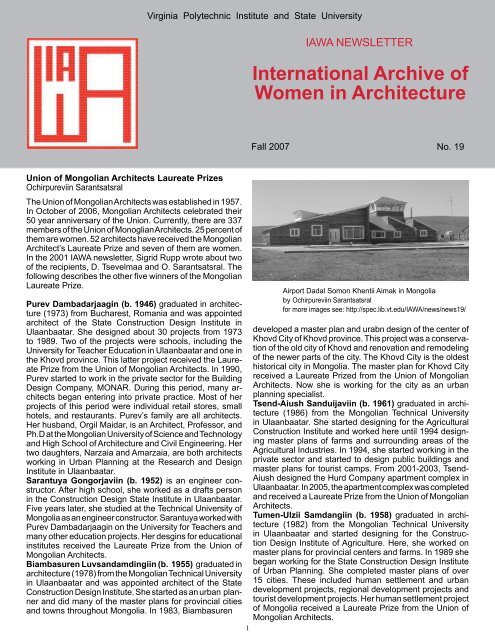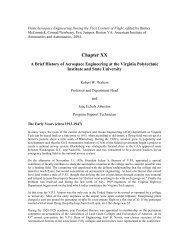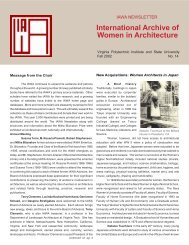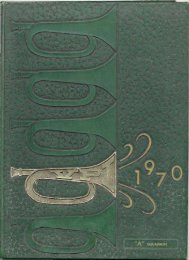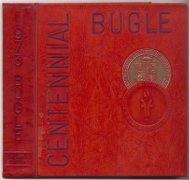International Archive of Women in Architecture - Special Collections
International Archive of Women in Architecture - Special Collections
International Archive of Women in Architecture - Special Collections
You also want an ePaper? Increase the reach of your titles
YUMPU automatically turns print PDFs into web optimized ePapers that Google loves.
Virg<strong>in</strong>ia Polytechnic Institute and State University<br />
IAWA NEWSLETTER<br />
<strong>International</strong> <strong>Archive</strong> <strong>of</strong><br />
<strong>Women</strong> <strong>in</strong> <strong>Architecture</strong><br />
Fall 2007 No. 19<br />
Union <strong>of</strong> Mongolian Architects Laureate Prizes<br />
Ochirpurevi<strong>in</strong> Sarantsatsral<br />
The Union <strong>of</strong> Mongolian Architects was established <strong>in</strong> 1957.<br />
In October <strong>of</strong> 2006, Mongolian Architects celebrated their<br />
50 year anniversary <strong>of</strong> the Union. Currently, there are 337<br />
members <strong>of</strong> the Union <strong>of</strong> Monoglian Architects. 25 percent <strong>of</strong><br />
them are women. 52 architects have received the Mongolian<br />
Architect’s Laureate Prize and seven <strong>of</strong> them are women.<br />
In the 2001 IAWA newsletter, Sigrid Rupp wrote about two<br />
<strong>of</strong> the recipients, D. Tsevelmaa and O. Sarantsatsral. The<br />
follow<strong>in</strong>g describes the other five w<strong>in</strong>ners <strong>of</strong> the Mongolian<br />
Laureate Prize.<br />
Purev Dambadarjaag<strong>in</strong> (b. 1946) graduated <strong>in</strong> architecture<br />
(1973) from Bucharest, Romania and was appo<strong>in</strong>ted<br />
architect <strong>of</strong> the State Construction Design Institute <strong>in</strong><br />
Ulaanbaatar. She designed about 30 projects from 1973<br />
to 1989. Two <strong>of</strong> the projects were schools, <strong>in</strong>clud<strong>in</strong>g the<br />
University for Teacher Education <strong>in</strong> Ulaanbaatar and one <strong>in</strong><br />
the Khovd prov<strong>in</strong>ce. This latter project received the Laureate<br />
Prize from the Union <strong>of</strong> Mongolian Architects. In 1990,<br />
Purev started to work <strong>in</strong> the private sector for the Build<strong>in</strong>g<br />
Design Company, MONAR. Dur<strong>in</strong>g this period, many architects<br />
began enter<strong>in</strong>g <strong>in</strong>to private practice. Most <strong>of</strong> her<br />
projects <strong>of</strong> this period were <strong>in</strong>dividual retail stores, small<br />
hotels, and restaurants. Purev’s family are all architects.<br />
Her husband, Orgil Maidar, is an Architect, Pr<strong>of</strong>essor, and<br />
Ph.D at the Mongolian University <strong>of</strong> Science and Technology<br />
and High School <strong>of</strong> <strong>Architecture</strong> and Civil Eng<strong>in</strong>eer<strong>in</strong>g. Her<br />
two daughters, Narzaia and Amarzaia, are both architects<br />
work<strong>in</strong>g <strong>in</strong> Urban Plann<strong>in</strong>g at the Research and Design<br />
Institute <strong>in</strong> Ulaanbaatar.<br />
Sarantuya Gongorjavi<strong>in</strong> (b. 1952) is an eng<strong>in</strong>eer constructor.<br />
After high school, she worked as a drafts person<br />
<strong>in</strong> the Construction Design State Institute <strong>in</strong> Ulaanbaatar.<br />
Five years later, she studied at the Technical University <strong>of</strong><br />
Mongolia as an eng<strong>in</strong>eer constructor. Sarantuya worked with<br />
Purev Dambadarjaag<strong>in</strong> on the University for Teachers and<br />
many other education projects. Her desg<strong>in</strong>s for educational<br />
<strong>in</strong>stitutes received the Laureate Prize from the Union <strong>of</strong><br />
Mongolian Architects.<br />
Biambasuren Luvsandamd<strong>in</strong>gi<strong>in</strong> (b. 1955) graduated <strong>in</strong><br />
architecture (1978) from the Mongolian Technical University<br />
<strong>in</strong> Ulaanbaatar and was appo<strong>in</strong>ted architect <strong>of</strong> the State<br />
Construction Design Institute. She started as an urban planner<br />
and did many <strong>of</strong> the master plans for prov<strong>in</strong>cial cities<br />
and towns throughout Mongolia. In 1983, Biambasuren<br />
1<br />
Airport Dadal Somon Khentii Aimak <strong>in</strong> Mongolia<br />
by Ochirpurevi<strong>in</strong> Sarantsatsral<br />
for more images see: http://spec.lib.vt.edu/IAWA/news/news19/<br />
developed a master plan and urabn design <strong>of</strong> the center <strong>of</strong><br />
Khovd City <strong>of</strong> Khovd prov<strong>in</strong>ce. This project was a conservation<br />
<strong>of</strong> the old city <strong>of</strong> Khovd and renovation and remodel<strong>in</strong>g<br />
<strong>of</strong> the newer parts <strong>of</strong> the city. The Khovd City is the oldest<br />
historical city <strong>in</strong> Mongolia. The master plan for Khovd City<br />
received a Laureate Prized from the Union <strong>of</strong> Mongolian<br />
Architects. Now she is work<strong>in</strong>g for the city as an urban<br />
plann<strong>in</strong>g specialist.<br />
Tsend-Aiush Sanduijavi<strong>in</strong> (b. 1961) graduated <strong>in</strong> architecture<br />
(1986) from the Mongolian Technical University<br />
<strong>in</strong> Ulaanbaatar. She started design<strong>in</strong>g for the Agricultural<br />
Construction Institute and worked here until 1994 design<strong>in</strong>g<br />
master plans <strong>of</strong> farms and surround<strong>in</strong>g areas <strong>of</strong> the<br />
Agricultural Industries. In 1994, she started work<strong>in</strong>g <strong>in</strong> the<br />
private sector and started to design public build<strong>in</strong>gs and<br />
master plans for tourist camps. From 2001-2003, Tsend-<br />
Aiush designed the Hurd Company apartment complex <strong>in</strong><br />
Ulaanbaatar. In 2005, the apartment complex was completed<br />
and received a Laureate Prize from the Union <strong>of</strong> Mongolian<br />
Architects.<br />
Tumen-Ulzii Samdangi<strong>in</strong> (b. 1958) graduated <strong>in</strong> architecture<br />
(1982) from the Mongolian Technical University<br />
<strong>in</strong> Ulaanbaatar and started design<strong>in</strong>g for the Construction<br />
Design Institute <strong>of</strong> Agriculture. Here, she worked on<br />
master plans for prov<strong>in</strong>cial centers and farms. In 1989 she<br />
began work<strong>in</strong>g for the State Construction Design Institute<br />
<strong>of</strong> Urban Plann<strong>in</strong>g. She completed master plans <strong>of</strong> over<br />
15 cities. These <strong>in</strong>cluded human settlement and urban<br />
development projects, regional development projects and<br />
tourist development projects. Her human settlement project<br />
<strong>of</strong> Mongolia received a Laureate Prize from the Union <strong>of</strong><br />
Mongolian Architects.
An Interview with Nobuko Nakahara and Hatsue<br />
Yamada<br />
The follow<strong>in</strong>g is an excerpt <strong>of</strong> an <strong>in</strong>terview <strong>of</strong> Nobuko Nakahara<br />
and Hatsue Yamada by Junko Matsukawa-Tsuchida<br />
held on May 24th, 2005 at the guest room <strong>in</strong> the Japan Federation<br />
<strong>of</strong> Architects and Build<strong>in</strong>g Eng<strong>in</strong>eers Association. Ms.<br />
Nakahara and Ms. Yamada both became forerunners <strong>in</strong> the<br />
field <strong>of</strong> architecture immediately after World War II. In 1958,<br />
they set up “Hayashi, Yamada and Nakahara Architectural<br />
Design<strong>in</strong>g Coterie” along with Masako Hayashi. From then<br />
on, they designed various build<strong>in</strong>gs and exerted a great deal<br />
<strong>of</strong> <strong>in</strong>fluence on other women pursu<strong>in</strong>g architecture careers.<br />
In 2000, when Masako Hayashi died, the <strong>of</strong>fice was closed<br />
after forty years <strong>of</strong> practice. Junko Matsukawa-Tsuchida<br />
<strong>in</strong>terviewed them about their experiences.<br />
Matsukawa-Tsuchida: Would you please beg<strong>in</strong> with the<br />
topic <strong>of</strong> August 15th, 1945?<br />
Nakahara: When I entered a girls’ high school <strong>in</strong> 1941,<br />
the Pacific War broke out. In 1945, I was kicked out from<br />
the girls’ high school after only 4 years. I was a so-called<br />
“child <strong>of</strong> war.” The girls’ high school was turned <strong>in</strong>to a factory<br />
mak<strong>in</strong>g military aviators’ uniforms for the youth. In the<br />
meantime, the war came to an end. I was born <strong>in</strong> Urawa<br />
(Saitama pref.) and I still lived <strong>in</strong> Urawa when the war was<br />
over. In Urawa, the damage from air raids was not so serious.<br />
My house was not burned down and existed as it had<br />
been. We were accustomed to liv<strong>in</strong>g <strong>in</strong> the dark. We were<br />
not allowed to light up under the control <strong>of</strong> lights. We had to<br />
reduce the light so that only a small part <strong>of</strong> the house was<br />
bright. So it was very difficult to read books. Everybody got<br />
together <strong>in</strong> one room. Just like that. When the war ended<br />
I felt emancipated. I felt how bright the world was. S<strong>in</strong>ce<br />
then I became used to pay<strong>in</strong>g much attention to “light and<br />
shadow”.<br />
Yamada: I was evacuated from Tokyo to Lake Kawaguchi<br />
at the foot <strong>of</strong> Mt. Fuji. On the day when the war was over,<br />
it was very f<strong>in</strong>e. I was out <strong>of</strong> my house. So I did not listen to<br />
the Emperor’s voice on the radio. I felt as if I got released<br />
from someth<strong>in</strong>g.<br />
Matsukawa-Tsuchida: What was your motivation to take<br />
up architecture? Your apprenticeship, and encounters with<br />
the people <strong>in</strong> the field <strong>of</strong> architecture…<br />
Yamada: Lake Kawaguchi was free from air raids. Therefore,<br />
I didn’t have any severe experience <strong>of</strong> the war such<br />
as see<strong>in</strong>g the houses burn<strong>in</strong>g down before my eyes. Everybody<br />
lacked <strong>in</strong>formation <strong>in</strong> those days. But my father<br />
recommended Japan <strong>Women</strong>’s College as the best for me<br />
to study at. I took an entrance exam<strong>in</strong>ation. The department<br />
<strong>of</strong> life and arts was newly set up at that time. I was<br />
one <strong>of</strong> the first students to enter that department. As I was<br />
attracted by the word “arts”, I applied for the department.<br />
As I didn’t study anyth<strong>in</strong>g at the girls’ high school, I had no<br />
idea <strong>of</strong> what I was good at, or bad at. Because <strong>of</strong> malnutrition,<br />
I was always sleepy, while attend<strong>in</strong>g at any class. But<br />
design<strong>in</strong>g and draw<strong>in</strong>g class was different. Even if I sit up<br />
all night, study<strong>in</strong>g design<strong>in</strong>g and draw<strong>in</strong>g,<br />
2<br />
the night passed very quickly. It was very <strong>in</strong>terest<strong>in</strong>g and<br />
attractive to me. Gradually my desire to cont<strong>in</strong>ue study<strong>in</strong>g<br />
design<strong>in</strong>g and draw<strong>in</strong>g at any cost grew stronger and stronger.<br />
Soon after graduat<strong>in</strong>g from Japan <strong>Women</strong>’s University <strong>in</strong><br />
1951, I happened to meet and talk with Pr<strong>of</strong>. Tokiji Chuzenji<br />
(<strong>in</strong> charge <strong>of</strong> design<strong>in</strong>g and draw<strong>in</strong>g class) <strong>in</strong> the streetcar.<br />
Tak<strong>in</strong>g advantage <strong>of</strong> it, I got employed by him at Azusa<br />
Design Office. Pr<strong>of</strong>. Chuzenji said, “I don’t know when the<br />
<strong>of</strong>fice will be closed. I am not sure if I can get enough work<br />
to hire the members”, which was very impressive. At first,<br />
I was very <strong>in</strong>nocent. For example, I was very glad when<br />
he praised me for stamp<strong>in</strong>g the seal correctly and nicely<br />
(laughs), or when he complimented me on my good writ<strong>in</strong>g<br />
<strong>of</strong> specifications. Azusa was located <strong>in</strong> G<strong>in</strong>za which<br />
was full <strong>of</strong> energy for facilitat<strong>in</strong>g reconstruction <strong>of</strong> Japan.<br />
The restoration <strong>of</strong> Japan started from the place <strong>of</strong> G<strong>in</strong>za, I<br />
would say. In Hibiya, there was a Tokyo metropolitan library,<br />
where I <strong>of</strong>ten went dur<strong>in</strong>g the lunch time. I worked <strong>in</strong> G<strong>in</strong>za<br />
for about 3 years. I was <strong>in</strong> charge <strong>of</strong> design<strong>in</strong>g furniture.<br />
In “Azusa”, we had a lot <strong>of</strong> work for the <strong>of</strong>fice build<strong>in</strong>gs <strong>of</strong><br />
the companies such as Taisho Mar<strong>in</strong> Insurance Co. and<br />
Nihon Fire Insurance Co. I designed a lot <strong>of</strong> furniture for the<br />
branch <strong>of</strong>fices <strong>of</strong> Japan Air L<strong>in</strong>es, too. But I hadn’t learned<br />
design<strong>in</strong>g furniture at Japan <strong>Women</strong>’s University. There was<br />
a friend work<strong>in</strong>g for the design<strong>in</strong>g division <strong>of</strong> Mitsukoshi<br />
Department Store. Thanks to her, I was allowed to go there<br />
to learn design<strong>in</strong>g or check<strong>in</strong>g orig<strong>in</strong>al sizes. The design<strong>in</strong>g<br />
division <strong>of</strong> Mitsukoshi was highly sophisticated at that<br />
time. I was do<strong>in</strong>g my best anyway. Now I fully realize that I<br />
could push on so furiously because <strong>of</strong> my be<strong>in</strong>g <strong>in</strong>nocent<br />
and lots <strong>of</strong> energy <strong>in</strong> my twenties.<br />
Nakahara: Anyway the war was over. After graduat<strong>in</strong>g from<br />
the girls’ high school, I entered Kasei Gaku<strong>in</strong> <strong>Special</strong> School<br />
<strong>in</strong> 1945. Someone recommended, “You had better study<br />
there. They educate women to be a good housewife and<br />
a good mother” (laughs). There was no reason to oppose,<br />
s<strong>in</strong>ce I had no idea.<br />
Anyway I entered the department <strong>of</strong> health education.<br />
I studied Japanese cook<strong>in</strong>g, Western cook<strong>in</strong>g, Ch<strong>in</strong>ese<br />
cook<strong>in</strong>g, and confectioneries. After graduation, I came to<br />
realize what I had studied was not what I really wanted to<br />
study. I decided to study architecture. I entered Musashi<br />
Industrial University <strong>in</strong> 1951. Someone advised me to study<br />
under Pr<strong>of</strong>. Kurata, because he was excellent and had a<br />
good personality. Around that time was when “the cubic<br />
m<strong>in</strong>imum house” designed by Mr. Ikebe (Kiyoshi) was made<br />
public. I was eager to work under him. Then I got a chance<br />
to be <strong>in</strong>troduced to Mr. Ikebe. The <strong>of</strong>fice <strong>of</strong> Mr. Ikebe was<br />
located <strong>in</strong> Sh<strong>in</strong>kyoutei, a Ch<strong>in</strong>ese restaurant which still<br />
exists now. At that time, it was a four story Ch<strong>in</strong>ese restaurant.<br />
On its ro<strong>of</strong>, there was a space which had not been<br />
burnt by war, where his <strong>of</strong>fice was located. 10 people were<br />
work<strong>in</strong>g <strong>in</strong> that space surrounded by galvanized iron sheets<br />
which were burnt. “If you can design the space to <strong>in</strong>stall<br />
11 desks, then I will employ you”, he said (laughs). I tried<br />
hard calculat<strong>in</strong>g width <strong>of</strong> the path necessary to <strong>in</strong>stall one<br />
more desk. F<strong>in</strong>ally I could do it, and took my plan to him.<br />
“Once you made it, then it can’t be helped hir<strong>in</strong>g you”, he<br />
said (laughs). So I
started <strong>of</strong>f work<strong>in</strong>g at his <strong>of</strong>fice.<br />
Matsukawa-Tsuchida: Please talk about the establishment<br />
<strong>of</strong> “PODOKO”, and the establishment <strong>of</strong> “Hayashi, Yamada,<br />
and Nakahara Architectural Design<strong>in</strong>g Coterie”.<br />
Yamada: PODOKO was a group <strong>of</strong> women architects, <strong>in</strong>augurated<br />
on September 14 <strong>in</strong> 1953. While Ms. Yoko Kishimoto<br />
(formerly Kondo) and Ms. Atsuko Funabiki (formerly Tanaka)<br />
were work<strong>in</strong>g for a design<strong>in</strong>g <strong>of</strong>fice, they were <strong>of</strong>ten treated<br />
with contempt on the build<strong>in</strong>g site, only because they were<br />
women. The people around them thought it better to call<br />
more women architects to get together. In response to their<br />
advice, we began to seek out women architects and set up<br />
an association <strong>of</strong> women architects. The first meet<strong>in</strong>g was<br />
held at Yoshikawa Design<strong>in</strong>g Office located <strong>in</strong> the build<strong>in</strong>g.<br />
About 29 young women architects at age 18 to 26 years old,<br />
gathered together dubiously, with a notice <strong>of</strong> <strong>in</strong>auguration<br />
ceremony <strong>in</strong> their hands.<br />
Nakahara: There was a person who studied Esperanto. It<br />
was Ms. Makoto Okumura who selected the words, pensedo,<br />
kiskutedo, and kureedo, <strong>in</strong> Esperanto mean<strong>in</strong>g “while th<strong>in</strong>k<strong>in</strong>g,<br />
discuss<strong>in</strong>g, and creat<strong>in</strong>g” for the name <strong>of</strong> the association.<br />
The association was given such a good name.<br />
Yamada: It is very difficult for women architects to unite <strong>in</strong><br />
the society <strong>of</strong> today, where there is a flood <strong>of</strong> <strong>in</strong>formation,<br />
and people have various values. In those days there were<br />
only about 29 women work<strong>in</strong>g <strong>in</strong> the field <strong>of</strong> architecture<br />
and design<strong>in</strong>g, I guess. If women architects would collect<br />
today the total number must be enormous.<br />
Nakahara: I am not sure whether it was <strong>Women</strong>’s Society<br />
or <strong>Women</strong>’s Association <strong>in</strong> Yokohama city. But anyway, they<br />
happened to <strong>of</strong>fer a job to us. They <strong>in</strong>tended to set up a<br />
hall for preborn babies to youth. The people <strong>in</strong> Yokohama<br />
were very enthusiastic about it. So we went to Yokohama<br />
every week. Ms. Hayashi worked very hard. And I did, too.<br />
Especially, for me, it was my first job to come. The <strong>of</strong>fer did<br />
not come to us f<strong>in</strong>ally, but we were able to set up our <strong>of</strong>fice<br />
anyway.<br />
Yamada: In those days, Seike Laboratory (Tokyo Industrial<br />
University) and Ikebe Laboratory (Tokyo University) were the<br />
most active. Ms. Hayashi (Masako) used to belong to Seike<br />
Laboratory and Ms. Nakahara was <strong>in</strong> Ikebe Laboratory. I<br />
was so busy that I seldom attended a field trip <strong>of</strong> PODOKO.<br />
Moreover as I got married, it became all the more difficult<br />
to attend.<br />
Matsukawa-Tsuchida: Please talk about the houses you<br />
designed: “the Last House to Live <strong>in</strong>”, etc.<br />
Nakahara: The first build<strong>in</strong>g I designed at Ikebe Laboratory<br />
was a tea ceremony room. When I was work<strong>in</strong>g for the Architectural<br />
Design<strong>in</strong>g Coterie, the first build<strong>in</strong>g I designed was<br />
also a tea ceremony room. I didn’t know why I was assigned<br />
to design so many tea ceremony rooms. I started learn<strong>in</strong>g<br />
tea ceremony at last, when I was 40 years old. Now I still<br />
have a lot <strong>of</strong> <strong>in</strong>terest <strong>in</strong> the tea ceremony. Among my clients,<br />
many <strong>of</strong> them were practic<strong>in</strong>g tea ceremony. Some wealthy<br />
clients asked me to design a tea ceremony room, <strong>in</strong> spite<br />
<strong>of</strong> the fact that they seldom practiced tea ceremony at that<br />
time. They were wealthy enough to have a tea ceremony<br />
room and just wanted to show it <strong>of</strong>f. When such an <strong>of</strong>fer<br />
<strong>of</strong> design<strong>in</strong>g a tea ceremony room came to the <strong>of</strong>fice, I was<br />
almost always assigned to it.<br />
Yamada: There is a traditional way <strong>of</strong> liv<strong>in</strong>g <strong>in</strong> Japan. It is<br />
someth<strong>in</strong>g to do with Mono (th<strong>in</strong>gs) and Koto (do<strong>in</strong>g) which<br />
was said by Pr<strong>of</strong>. Shigefumi Suzuki. When you design a<br />
house, you should know about their way <strong>of</strong> liv<strong>in</strong>g and then<br />
you can design the house. When you build a bridge, first<br />
you have to know well about the people who will cross the<br />
bridge. Then you can start build<strong>in</strong>g a bridge. The house is<br />
where people grow up and br<strong>in</strong>g up their children. Such a<br />
way <strong>of</strong> th<strong>in</strong>k<strong>in</strong>g should come first. Other th<strong>in</strong>gs than that are<br />
all procedures or methodology <strong>of</strong> design<strong>in</strong>g. However, what<br />
comes first and what comes next are converse today. I have<br />
realized that the environment where people are grow<strong>in</strong>g up<br />
exerts a great deal <strong>of</strong> <strong>in</strong>fluence on the way <strong>of</strong> architectural<br />
design. In my case, I was raised at the house which now we<br />
call a traditional Japanese house where there were a liv<strong>in</strong>g<br />
room (chanoma) and a draw<strong>in</strong>g room (zashiki), and all the<br />
rooms had tatami mats without any air condition<strong>in</strong>g facilities<br />
<strong>in</strong> spite <strong>of</strong> high temperature and humidity. The thought <strong>of</strong><br />
“hare” was realized as a draw<strong>in</strong>g room and the thought <strong>of</strong><br />
“ke” was realized as a liv<strong>in</strong>g room. But they were negated<br />
completely at the end <strong>of</strong> the war. While our liv<strong>in</strong>g style has<br />
been chang<strong>in</strong>g from sitt<strong>in</strong>g down on tatami mats to sitt<strong>in</strong>g<br />
on the chair <strong>in</strong> life space, the thoughts <strong>of</strong> “hare” and “ke”<br />
are not translated well. For experiment’s sake, I designed<br />
a wide space <strong>in</strong> the entrance hall, which is not worth be<strong>in</strong>g<br />
called a formal liv<strong>in</strong>g room though, and a family room <strong>in</strong><br />
my house. I did the same <strong>in</strong> other houses, and they are<br />
still work<strong>in</strong>g well. Now I realize that the existence <strong>of</strong> the<br />
place <strong>of</strong> “hare is very important as nutrition to our mentality,<br />
under such miscellaneous circumstances. At first I thought<br />
I would soon get tired <strong>of</strong> my house. But even after 26 years<br />
<strong>of</strong> liv<strong>in</strong>g <strong>in</strong> my house, I haven’t got tired <strong>of</strong> it.<br />
Matsukawa-Tsuchida: Last please give us your comments<br />
on “For the Com<strong>in</strong>g 60 Years” especially for women<br />
architects.<br />
Nakahara: House design<strong>in</strong>g is very important. I hope that<br />
the younger people make a little more efforts to design better<br />
houses. I th<strong>in</strong>k that they seem to be somewhat neglectful <strong>in</strong><br />
their th<strong>in</strong>k<strong>in</strong>g. They had better study much harder. I myself<br />
want to do more. I want to do more house design<strong>in</strong>g. But<br />
I wonder if there is a job for me. Can I still manage to work<br />
well physically? These are the problems. The people <strong>of</strong><br />
today seem to have less volition to leave than before. As<br />
everybody doesn’t know how to live, they aren’t serious<br />
about their way <strong>of</strong> liv<strong>in</strong>g. I feel impatient at them.<br />
Yamada: At present I have a plan for the people <strong>in</strong> Kamakura<br />
for the com<strong>in</strong>g 60 years from now on. We haven’t done<br />
anyth<strong>in</strong>g special to the towns <strong>in</strong> Kamakura, just rely<strong>in</strong>g on<br />
the 800 years’ history <strong>of</strong> Kamakura. I th<strong>in</strong>k we should show<br />
our determ<strong>in</strong>ation to preserve and ma<strong>in</strong>ta<strong>in</strong> Kamakura. For<br />
that, I want to do someth<strong>in</strong>g. The group called “People and<br />
Town, Kamakura Network” associat<strong>in</strong>g people <strong>of</strong> rang<strong>in</strong>g<br />
from 20 years to 50 years old <strong>in</strong> the various fields, has already<br />
been <strong>in</strong>augurated. Slowly, but carefully and heartily, we will<br />
start wherever we can start. The group is very active now,<br />
ga<strong>in</strong>ed momentum by the current <strong>of</strong> the society. For the<br />
3
time be<strong>in</strong>g, I am engaged <strong>in</strong> excavat<strong>in</strong>g cultured and<br />
talented people. I am meet<strong>in</strong>g with the talented people <strong>in</strong><br />
the various k<strong>in</strong>ds <strong>of</strong> fields, receiv<strong>in</strong>g a great deal <strong>of</strong> fresh<br />
stimulus from them.<br />
Nakahara: There is one th<strong>in</strong>g that I would like to say to the<br />
women. Contrary to our expectation, the women quit their<br />
job so easily. The women, who I want to cont<strong>in</strong>ue work<strong>in</strong>g<br />
longer, tend to give up work<strong>in</strong>g, they wouldn’t grow up as<br />
experts <strong>in</strong> this field. They decide to quit their job not only<br />
for their own sake, but also for their family, or because <strong>of</strong><br />
social environment. It must be difficult for them to cont<strong>in</strong>ue<br />
work<strong>in</strong>g unless they have their strong will.<br />
Yamada: The number <strong>of</strong> women who keep on work<strong>in</strong>g is<br />
relatively small, compar<strong>in</strong>g with the number <strong>of</strong> women who<br />
graduated from the architectural course <strong>in</strong> university. In the<br />
end, it is concerned with whether they have a strong will to<br />
cont<strong>in</strong>ue. But compar<strong>in</strong>g our situation <strong>in</strong> the past with the<br />
present situation, I th<strong>in</strong>k it has become more difficult to keep<br />
on work<strong>in</strong>g than before. The problem is that the child rear<strong>in</strong>g<br />
support system <strong>of</strong> the society has not matured enough<br />
yet. Today it is not an age when only women must br<strong>in</strong>g up<br />
their children alone. Regardless <strong>of</strong> man or woman, both<br />
should cooperate with each other <strong>in</strong> different fields, which<br />
is especially important. I believe, as a result <strong>of</strong> th<strong>in</strong>k<strong>in</strong>g <strong>in</strong><br />
new way and keep<strong>in</strong>g a balance with each other, it must<br />
bear fruit <strong>in</strong> the end.<br />
Matsukawa-Tsuchida: I greatly appreciate your s<strong>in</strong>cere<br />
talk<strong>in</strong>g. Thank you very much.<br />
Bulgarian <strong>Women</strong> Architects<br />
Sonia A. Hirt<br />
Bulgaria was part <strong>of</strong> the Ottoman Empire for almost five<br />
centuries (1396-1879). Until 1943, when the S<strong>of</strong>ia Polytechnic<br />
added a department <strong>of</strong> architecture, Bulgarians<br />
were educated <strong>in</strong> Western European universities, ma<strong>in</strong>ly <strong>in</strong><br />
Austria and Germany, and some <strong>in</strong> France. Many European<br />
polytechnics began accept<strong>in</strong>g women at the end <strong>of</strong> WWI and<br />
Bulgarians were among the first to register. In November,<br />
2006 an exhibition was mounted <strong>in</strong> the Bulgarian capital<br />
<strong>of</strong> S<strong>of</strong>ia, display<strong>in</strong>g the work <strong>of</strong> the pioneer<strong>in</strong>g women<br />
architects <strong>of</strong> the 1920s and 1930s. The catalogue <strong>of</strong> this<br />
exhibition entitled Presences/Absences was donated to the<br />
IAWA by the curator Ljub<strong>in</strong>ka Stoilova, also a dist<strong>in</strong>guished<br />
architect and architectural historian.<br />
Initially, the S<strong>of</strong>ia Polytechnic accepted 44 students <strong>in</strong> the<br />
architecture department and 18 <strong>of</strong> them were women.<br />
Soon the number <strong>of</strong> students <strong>in</strong>creased with an additional<br />
148 men and 92 women, as most <strong>of</strong> those study<strong>in</strong>g abroad<br />
returned home to complete their education. Eventually<br />
the number <strong>of</strong> women <strong>in</strong> the architecture department surpassed<br />
the number <strong>of</strong> men prompt<strong>in</strong>g the new Communist<br />
Government to limit the acceptance <strong>of</strong> women <strong>in</strong> higher<br />
education to 50%.<br />
In 1995 and <strong>in</strong> 1998 several Bulgarian women architects<br />
donated materials to the IAWA. D<strong>in</strong>a Stancheva (b.<br />
1925) began her architectural studies <strong>in</strong> Paris, France and<br />
transferred to S<strong>of</strong>ia Polytechnic to complete her education<br />
(graduat<strong>in</strong>g <strong>in</strong> 1952). She worked <strong>in</strong> S<strong>of</strong>ia Design Organization<br />
“S<strong>of</strong>proekt” until her retirement <strong>in</strong> 1982. Nevena<br />
Kechedzhieva (b. 1927) graduated <strong>in</strong> 1951 and worked<br />
<strong>in</strong> the S<strong>of</strong>ia Design Organization “Glavproekt” until her<br />
retirement <strong>in</strong> 1984. Thereafter, she cont<strong>in</strong>ued to design <strong>in</strong><br />
her own <strong>of</strong>fice for private clients. Tsetsa N<strong>in</strong>ova (b. 1923)<br />
transferred from the University <strong>of</strong> Zagreb, Croatia (former<br />
Yugoslavia) to S<strong>of</strong>ia Polytechnic and graduated <strong>in</strong> 1949. She<br />
worked <strong>in</strong> the S<strong>of</strong>ia Design Organization “S<strong>of</strong>proekt” and<br />
after retirement opened her private practice (1986). Some<br />
<strong>of</strong> the achievements <strong>of</strong> these architects were published <strong>in</strong><br />
the IAWA Newsletter No. 9, 1997 and No. 11, 1999.<br />
Three younger women architects donated projects and photographs<br />
<strong>of</strong> their work <strong>in</strong> 2000. Radka Pavlova (b. 1933)<br />
graduated from the S<strong>of</strong>ia Polytechnic <strong>in</strong> 1956 and was appo<strong>in</strong>ted<br />
regional architect <strong>in</strong> the prov<strong>in</strong>cial town Blagoevgrad.<br />
Later she transferred to “S<strong>of</strong>proekt” (1981-1988) and after<br />
retirement began her private practice. Jana Vulchanova (b.<br />
1957) graduated <strong>in</strong> 1970 and worked for the S<strong>of</strong>ia adm<strong>in</strong>istration.<br />
Nadya Stamatova (b. 1957) graduated <strong>in</strong> 1981<br />
and was assigned to work <strong>in</strong> her native town Varna. The<br />
work <strong>of</strong> these architects is discussed <strong>in</strong> IAWA Newsletter<br />
No. 13, 2001. Last year several <strong>of</strong> these architects gave<br />
additional materials to their archives.<br />
The IAWA also obta<strong>in</strong>ed the work <strong>of</strong> seven other architects<br />
from Bulgaria. Lilia Bencheva-Gramatikova (b. 1929)<br />
graduated <strong>in</strong> 1953 and began her practice <strong>in</strong> “S<strong>of</strong>proekt”<br />
(1953-1965). She spent two years <strong>in</strong> Ulan Batar, Mongolia<br />
design<strong>in</strong>g the youth center and its adm<strong>in</strong>istrative build<strong>in</strong>g<br />
(1961-1963). Thereafter, she worked for several years <strong>in</strong><br />
the former East Germany design<strong>in</strong>g a neighborhood <strong>in</strong><br />
Halle Neustadt. Back <strong>in</strong> S<strong>of</strong>ia, Lilia Gramatikova moved<br />
to “Glavproekt” (1965-1985) design<strong>in</strong>g multi-family hous<strong>in</strong>g,<br />
educational facilities, and a comput<strong>in</strong>g center <strong>in</strong> the<br />
town <strong>of</strong> Vratza (orig<strong>in</strong>al draw<strong>in</strong>gs <strong>in</strong> the IAWA). The most<br />
admired and widely publicized achievement was Gramatikova’s<br />
design for a music high school for folk <strong>in</strong>struments<br />
and folk s<strong>in</strong>g<strong>in</strong>g <strong>in</strong> the village Shiroka Luka <strong>in</strong> the Rhodope<br />
mounta<strong>in</strong>s. Greek legends claim this was the home <strong>of</strong> the<br />
Thracian s<strong>in</strong>ger Orpheus. The school <strong>in</strong>tegrates auditoriums,<br />
practice rooms, and dormitories <strong>in</strong>to a cont<strong>in</strong>uous structure<br />
<strong>of</strong> <strong>in</strong>terconnected pavilions, thus creat<strong>in</strong>g harmony <strong>in</strong> scale,<br />
form, and construction with the surround<strong>in</strong>g houses and<br />
the natural environment. She was awarded medals (1979<br />
and 1980) and diplomas <strong>of</strong> merit (1981 and 1987) and her<br />
draw<strong>in</strong>gs were shown <strong>in</strong> many exhibitions (now <strong>in</strong> the IAWA).<br />
Snezha Daskalova Milkovska (b. 1925) graduated <strong>in</strong> 1950<br />
and worked <strong>in</strong> “S<strong>of</strong>proekt”, <strong>of</strong>ten <strong>in</strong> partnership with architect<br />
Olga Staneva, another graduate <strong>of</strong> S<strong>of</strong>ia Polytechnic. They<br />
specialized <strong>in</strong> public build<strong>in</strong>gs and hous<strong>in</strong>g design. After<br />
retirement Snezha opened her private <strong>of</strong>fice <strong>in</strong> S<strong>of</strong>ia design<strong>in</strong>g<br />
ma<strong>in</strong>ly s<strong>in</strong>gle-family houses. She donated to the IAWA<br />
five recent projects for vacation houses <strong>in</strong> the prov<strong>in</strong>ces.<br />
Snezha also donated a student project by her daughter<br />
Mar<strong>in</strong>a Markovska who was born <strong>in</strong> 1967 and died <strong>in</strong><br />
4
1994. Mar<strong>in</strong>a also studied architecture at the S<strong>of</strong>ia<br />
Polytechnic. Nadezhda Bogdanova Budevska (b. ?) was<br />
a classmate <strong>of</strong> Snezha Daskalova and graduated also <strong>in</strong><br />
1950. She also worked <strong>in</strong> “S<strong>of</strong>proekt” and cooperated with<br />
Olga Staneva on large projects such as the research <strong>in</strong>stitute<br />
for electro-chemical sources <strong>of</strong> electricity <strong>in</strong> S<strong>of</strong>ia <strong>of</strong> 1970.<br />
She also worked privately and donated to the IAWA six <strong>of</strong><br />
her design projects for vacation houses <strong>of</strong> the 1970’s and<br />
1980’s. Maria Georgieva Peeva (b. 1954) graduated <strong>in</strong> 1977<br />
and was sent to her birth town Shumen to jo<strong>in</strong> the design<br />
organization there. She headed a design group (1977-1980)<br />
and later the design section (1980-1989). As the political<br />
changes <strong>in</strong> Bulgaria began, Maria Peeva moved to Varna,<br />
the large town on the Black Sea shores, where she worked<br />
<strong>in</strong> Varna Design Organization (1989-1991) and later became<br />
Regional Architect <strong>of</strong> the Black Sea tourist region (2000-<br />
2006). In 1991 Maria Peeva established her private <strong>of</strong>fice<br />
<strong>in</strong> Varna design<strong>in</strong>g numerous vacation houses around the<br />
coast. Her sensitivity to local culture and environment are<br />
evident <strong>in</strong> her work. She donated some <strong>of</strong> her projects to<br />
the IAWA. Maria’s younger sister Rositsa Peeva-Popova<br />
(b. ?) is also an architect. The sisters grew up <strong>in</strong> a large<br />
house <strong>in</strong> Shumen where their uncle, an architect, had his<br />
<strong>of</strong>fice on the ground floor. The children loved to watch their<br />
uncle mak<strong>in</strong>g gypsum models and execut<strong>in</strong>g beautiful <strong>in</strong>k<br />
draw<strong>in</strong>gs. They decided to become architects at an early<br />
age. Their father, Georgi Peev, was a jurist-council who<br />
devoted his free time to watercolor pa<strong>in</strong>t<strong>in</strong>g. He helped his<br />
daughters to develop a sense <strong>of</strong> colorful beauty. Rositsa<br />
jo<strong>in</strong>ed her sister at S<strong>of</strong>ia Polytechnic, (graduated <strong>in</strong> 1981)<br />
and was also assigned to work <strong>in</strong> Shumen (1981?). She<br />
married an architect and had three children. In 2006 Rositsa’s<br />
family moved to Varna. Two <strong>of</strong> her designs are now <strong>in</strong> the<br />
IAWA. Iskra Nikolova-Petrova (b. 1952) graduated <strong>in</strong> 1977<br />
and began work<strong>in</strong>g <strong>in</strong> the State Design and Construction<br />
organization “Technoekspertstroi” located <strong>in</strong> S<strong>of</strong>ia. This<br />
organization built <strong>in</strong> Africa and the Near-East. Iskra designed<br />
several hospitals <strong>in</strong> Lebanon and Yemen (between 1977 and<br />
1997); hotels and hous<strong>in</strong>g <strong>in</strong> Kuwait, United Arab Emirates,<br />
Lebanon, and <strong>in</strong> Yemen; the Government Center <strong>in</strong> Algeria<br />
(1985); and cultural and educational facilities <strong>in</strong> Ghana.<br />
Iskra Petrova also participated <strong>in</strong> many <strong>in</strong>ternational<br />
competitions and donated to the IAWA her competition<br />
project for two hous<strong>in</strong>g neighborhoods <strong>in</strong> Nigeria (<strong>of</strong> 1981).<br />
Krasimira Zheliazkova Choneva was born <strong>in</strong> Varna where<br />
swimm<strong>in</strong>g <strong>in</strong> the Black Sea was the dom<strong>in</strong>at<strong>in</strong>g sport. While<br />
her two older brothers studied electronics and technology<br />
<strong>in</strong> S<strong>of</strong>ia Polytechnic, Krasimira enrolled <strong>in</strong> Construction and<br />
Technology Highschool <strong>in</strong> Varna to cont<strong>in</strong>ue her swimm<strong>in</strong>g<br />
tra<strong>in</strong><strong>in</strong>g and to w<strong>in</strong> local and national competitions. Her<br />
aim was to compete <strong>in</strong>ternationally, while her “love and<br />
commitment for architecture developed only after she began<br />
work<strong>in</strong>g (<strong>in</strong> 1958) <strong>in</strong> the construction <strong>of</strong>fice <strong>of</strong> Varna’s ship<br />
build<strong>in</strong>g <strong>in</strong>dustrial complex”, Krasimira recalls, “In 1959 I won<br />
the competition for draftsman <strong>in</strong> Varna’s design organization<br />
where I worked until my mandatory retirement <strong>in</strong> 1990.” “This<br />
was my ‘university’ tra<strong>in</strong><strong>in</strong>g and education, as I worked with<br />
lead<strong>in</strong>g architects on numerous projects,” she expla<strong>in</strong>ed.<br />
Soon she was entrusted to design small build<strong>in</strong>gs such as<br />
Music School for folk <strong>in</strong>struments and folk s<strong>in</strong>g<strong>in</strong>g;<br />
Lilia Bencheva-Gramatikova<br />
the Pavilion with chang<strong>in</strong>g rooms and showers, table<br />
tennis room, lounge room and bar to the tennis courts <strong>of</strong><br />
Eux<strong>in</strong>ograd palace near Varna (1958). She <strong>in</strong>cluded all<br />
spaces <strong>in</strong> four cyl<strong>in</strong>drical structures united on a large terrace<br />
and carefully <strong>in</strong>tegrated <strong>in</strong> the palace’s park. S<strong>in</strong>ce 1971<br />
Krasimera was <strong>in</strong>volved <strong>in</strong> the construction <strong>of</strong> multi-family<br />
hous<strong>in</strong>g from prefabricated panels. The modular panels<br />
(5.10x3.60 meters) allowed for easy functional arrangement<br />
<strong>of</strong> spaces and for speedy but monotonous construction.<br />
Krasimira won a competition for design<strong>in</strong>g façade elements<br />
<strong>in</strong>tegrat<strong>in</strong>g color to improve the build<strong>in</strong>gs appearance. For<br />
her contributions to the pr<strong>of</strong>ession, Krasimira Choneva<br />
was accepted as a member <strong>of</strong> the Union <strong>of</strong> Bulgarian<br />
Architects, an honor that shaped her future and gave her<br />
the right <strong>of</strong> private practice after the change <strong>of</strong> the Bulgarian<br />
government <strong>in</strong> 1989. In 1990 Krasimira opened her private<br />
architectural firm and soon was jo<strong>in</strong>ed by her daughter<br />
Liuliana Mar<strong>in</strong>ova Choneva (b. 1962) who graduated the<br />
S<strong>of</strong>ia Polytechnic <strong>in</strong> 1990.<br />
The IAWA is grateful to these architects and looks forward to<br />
cont<strong>in</strong>uous donations, as the awareness <strong>of</strong> the importance<br />
<strong>of</strong> preservation grows.<br />
From Your Care To Ours: Donations to the IAWA<br />
Adapted and repr<strong>in</strong>ted from an earlier article by Gerri<br />
Schaad and Laura Smith<br />
The <strong>International</strong> <strong>Archive</strong> <strong>of</strong> <strong>Women</strong> <strong>in</strong> <strong>Architecture</strong> is supported<br />
by two units at Virg<strong>in</strong>ia Tech. The College <strong>of</strong> <strong>Architecture</strong><br />
and Urban Studies (CAUS) at Virg<strong>in</strong>ia Tech promotes<br />
the IAWA and women <strong>in</strong> architecture through lectures by<br />
noted architects, exhibitions, and publish<strong>in</strong>g this<br />
5
newsletter. The materials—conceptual design and work<strong>in</strong>g<br />
draw<strong>in</strong>gs, artwork, photographs, <strong>of</strong>fice and research files,<br />
correspondence, and other materials are located and ma<strong>in</strong>ta<strong>in</strong>ed<br />
<strong>in</strong> the Digital Library and <strong>Archive</strong>s, Newman Library,<br />
Virg<strong>in</strong>ia Tech. This collection currently holds the papers <strong>of</strong><br />
over 300 architects, landscape architects, <strong>in</strong>terior designers,<br />
architecture associations, and other women work<strong>in</strong>g <strong>in</strong> the<br />
built environment. These materials are used for historical<br />
research by architectural and design students, historians<br />
and scholars.<br />
<strong>Collections</strong> make their way to the archive by different<br />
routes. In some cases women contact the archivist directly,<br />
while <strong>in</strong> other cases, the IAWA Advisors actively seek new<br />
collections from colleagues. In the case <strong>of</strong> the Alberta<br />
Pfeiffer Architectural Papers, Pfeiffer <strong>in</strong>troduced herself<br />
to the archivist <strong>in</strong> 1988. She wanted to reta<strong>in</strong> her papers<br />
and draw<strong>in</strong>gs while she was alive, but deeded them to the<br />
<strong>Archive</strong> <strong>in</strong> her will. The collection was added to the <strong>Archive</strong><br />
after her death <strong>in</strong> 1994. The Han Schroeder Architectural<br />
Papers were donated to the <strong>Archive</strong> when Schroeder was<br />
solicited by IAWA founder Milka Bliznakov, who encouraged<br />
her, as she has so many others, to see the <strong>Archive</strong> as a place<br />
where the materials will be preserved and made available<br />
to researchers. The IAWA has grown s<strong>in</strong>ce its <strong>in</strong>ception <strong>in</strong><br />
1985. Many potential donors <strong>of</strong> architectural and design<br />
materials, or their heirs, have contacted the <strong>Archive</strong> directly,<br />
<strong>in</strong>quir<strong>in</strong>g about how to donate their collections. One <strong>of</strong> the<br />
first questions that is asked when a collection is <strong>of</strong>fered is<br />
“what k<strong>in</strong>d <strong>of</strong> stuff do you want?” In a perfect world where<br />
a person has saved all the products that result from their<br />
activities, they should donate the entire collection. Everyth<strong>in</strong>g<br />
is <strong>of</strong> scholarly <strong>in</strong>terest, from the first <strong>in</strong>quiry from a client<br />
about design<strong>in</strong>g a structure or space, the <strong>in</strong>itial conceptual<br />
draw<strong>in</strong>gs, the correspondence and specs regard<strong>in</strong>g the<br />
project, the project files, the draw<strong>in</strong>gs, the construction<br />
photographs, to the f<strong>in</strong>al photographs. All <strong>of</strong> these items<br />
tell the story <strong>of</strong> the thought process <strong>of</strong> the architects and<br />
how these thoughts <strong>in</strong>teracted with the client‘s desire, the<br />
available construction material, and the current trends, to<br />
achieve the end product, be it house, commercial build<strong>in</strong>g,<br />
landscape design, product or <strong>in</strong>terior space. In addition, if<br />
a woman has published papers or books, corresponded<br />
with others about architectural issues, issues related to<br />
work<strong>in</strong>g <strong>in</strong> a male dom<strong>in</strong>ated pr<strong>of</strong>ession, or taught, these<br />
orig<strong>in</strong>al writ<strong>in</strong>gs and files are <strong>of</strong> <strong>in</strong>terest to the <strong>Archive</strong>.<br />
Published material will generally be cataloged for the rare<br />
book section <strong>of</strong> the department. Presentations and notes<br />
from memberships <strong>in</strong> architectural and design associations<br />
or exhibits are also candidates for donation. Contact<strong>in</strong>g the<br />
archivist for details about collections and their management<br />
is important. If an architect did not save all <strong>of</strong> this type <strong>of</strong><br />
material, then donat<strong>in</strong>g what she does have is acceptable.<br />
Mylar draw<strong>in</strong>gs, the orig<strong>in</strong>als, are the preferred choice for<br />
the f<strong>in</strong>al draw<strong>in</strong>gs. Archivists suggest that architects use<br />
acid-free papers for sketches, but would rather have sketches<br />
made on other mediums, than no sketches. Electronic files<br />
are very dependent on s<strong>of</strong>tware<br />
and hardware. Do you still have five-<strong>in</strong>ch floppy computer<br />
disks? And do you have a computer that will read them?<br />
Pr<strong>in</strong>t out CAD files or the correspondence that is <strong>in</strong> electronic<br />
formats. Specs tell how the structure should have been<br />
built and photographs can show future researchers what<br />
the structure looked like <strong>in</strong> its physical sett<strong>in</strong>g. Newspaper<br />
clipp<strong>in</strong>gs and publicity materials can also tell historians how<br />
the structure was received and viewed at its <strong>in</strong>itial open<strong>in</strong>g<br />
and throughout its life.<br />
The <strong>Archive</strong> discourages the donation <strong>of</strong> records, which<br />
<strong>in</strong>clude items that family members or the donor consider too<br />
personal for the world to view, or materials that they frequently<br />
use. Donors should consider the archive as a place for historical<br />
records and not as a records management facility. If<br />
the materials are <strong>in</strong> danger <strong>of</strong> be<strong>in</strong>g destroyed or com<strong>in</strong>g<br />
to harm, terms can be negotiated. <strong>Collections</strong> consist<strong>in</strong>g<br />
<strong>of</strong> photocopies are also discouraged. Researchers are not<br />
satisfied with photocopies and will ask for the location <strong>of</strong><br />
the orig<strong>in</strong>als. Also, if someone has donated a portion <strong>of</strong> her<br />
materials to one repository, all material should be given to<br />
the same repository. It is easier for researchers to gather<br />
<strong>in</strong>formation when they only need to visit one site.<br />
6
The <strong>Archive</strong> seldom places restrictions on the collections<br />
and as a rule discourages donors from giv<strong>in</strong>g materials that<br />
may require complicated restrictions. Restrictions that would<br />
be allowed would be to protect the privacy <strong>of</strong> an <strong>in</strong>dividual,<br />
and would have a time limit. Restrictions defeat the very<br />
purpose <strong>of</strong> the <strong>Archive</strong>, which is to make the materials<br />
available to researchers. A collection might not be accepted<br />
<strong>in</strong>to the <strong>Archive</strong> if too many restrictions or conditions are<br />
placed on its use.<br />
At the time <strong>of</strong> the donation, the donor will sign a deed <strong>of</strong><br />
the collections development policy located on the IAWA web<br />
page - http://spec.lib.vt.edu/iawa/ which transfers ownership<br />
and copyright to the <strong>Archive</strong>. This enables the archivist to<br />
allow photocopy<strong>in</strong>g by researchers, the use <strong>of</strong> materials <strong>in</strong><br />
teach<strong>in</strong>g or presentations, and the display <strong>of</strong> select items<br />
<strong>in</strong> web exhibits. If the <strong>Archive</strong> does not receive this permission<br />
with the deed <strong>of</strong> gift, then the donor or heirs need to<br />
be contacted every time a researcher desires to use the<br />
materials. If contact cannot be made, then the material<br />
cannot be used, and the purpose <strong>of</strong> the creation <strong>of</strong> the<br />
IAWA is defeated. For further <strong>in</strong>formation about donat<strong>in</strong>g<br />
a collection please contact Gail McMillan, Archivist, at<br />
gailmac@vt.edu or 540-231-6308 or look at the collections<br />
development policy located on the IAWA web page - http://<br />
spec.lib.vt.edu/iawa/.<br />
Note from the Chair<br />
Donna Dunay<br />
On behalf <strong>of</strong> the IAWA we wish to extend a warm thank you<br />
to the friends <strong>of</strong> the IAWA who have contributed donations<br />
to the collections and support for the IAWA: Milka Bliznakov,<br />
Nadezhda Bidevska, Kay Edge, Eliana Cardenas, Krasimira<br />
Choneva, Snezha Daskalova, Mar<strong>in</strong>e Milkovska, E. Maria<br />
Roth, Anna Sokol<strong>in</strong>a, Inessa N. Sliunkova, Audrey Brians,<br />
Krist<strong>in</strong>e Fallon, Lia Gramatikova, Jane Hast<strong>in</strong>gs, Yumiko<br />
Hugashi, Junko Matsukawa, Maria von der Weppen, Doris<br />
Cole, Albena Dimitrova-Todorov, Ljub<strong>in</strong>ka Stoilova, Ulla Terl<strong>in</strong>den,<br />
Heidi and Peter Wenger, Dorothee K<strong>in</strong>g, The Hast<strong>in</strong>gs<br />
Group, John Thorp and Karen Elliott, Rob<strong>in</strong> Leenhouts, Eva<br />
Huebscher, Sandra Vitzthum, Blanche Lemco van G<strong>in</strong>kel,<br />
Marlene Shade, Ruth Connell, Christ<strong>in</strong>e Bev<strong>in</strong>gton, Beatte<br />
Schnitter, and Jennifer Browne.<br />
S<strong>in</strong>ce the <strong>in</strong>ception <strong>of</strong> the IAWA, an <strong>in</strong>ternational Board<br />
<strong>of</strong> Advisors has guided the organization with the work <strong>of</strong><br />
solicit<strong>in</strong>g, collect<strong>in</strong>g and promot<strong>in</strong>g archives <strong>of</strong> women <strong>in</strong><br />
architecture. We wish all past advisors who cont<strong>in</strong>ue to<br />
be active on behalf <strong>of</strong> the IAWA and to extend a special<br />
thank you to advisors leav<strong>in</strong>g the Board - Heather Ball<br />
and Kathleen Cruise - and welcome new advisors to the<br />
Board - K.C. Arceneaux, Marilyn Casto, Martha Thorne,<br />
and Ann Wittl<strong>in</strong>.<br />
Items <strong>of</strong> particular note, it br<strong>in</strong>gs me pleasure to announce<br />
two <strong>of</strong> the 5th Annual Bliznakov Prize w<strong>in</strong>ners have<br />
recently published their work. Carmen Espegel’s book<br />
Hero<strong>in</strong>as del Espacio (Hero<strong>in</strong>es <strong>of</strong> the Space) and Bobbye<br />
Tigerman’s research, “I am Not a Decorator” Florence Knoll,<br />
the Knoll Plann<strong>in</strong>g Unit, and the Mak<strong>in</strong>g <strong>of</strong> the Modern Office<br />
is published <strong>in</strong> the Journal <strong>of</strong> Design History, 2007 Spr<strong>in</strong>g.<br />
Doris Cole used materials from the IAWA for her new book<br />
Candid Reflections: Letters from <strong>Women</strong> <strong>in</strong> <strong>Architecture</strong><br />
1972 & 2004.<br />
Last fall The IAWA Symposium held at Virg<strong>in</strong>ia Tech featured:<br />
Walk<strong>in</strong>g through Talies<strong>in</strong> by Lois Gottlieb, Frank Lloyd<br />
Wright apprentice, San Francisco, California; The History<br />
<strong>of</strong> Mongolian <strong>Architecture</strong> by Ochirpurevi<strong>in</strong> Sarantsatral,<br />
Ulaanbataar, Mongolia; Collect<strong>in</strong>g, Archiv<strong>in</strong>g and Exhibit<strong>in</strong>g<br />
Digital Design Data by Krist<strong>in</strong>e Fallon, FAIA, Chicago,<br />
Ill<strong>in</strong>ois; and Laboratory for Innovators <strong>of</strong> Quality <strong>of</strong> Life by<br />
Junko Matsukawa-Tsuchida, Tokyo, Japan.<br />
One fasc<strong>in</strong>at<strong>in</strong>g glimpse <strong>in</strong>to the IAWA was displayed last<br />
fall with the follow<strong>in</strong>g exhibitions from the IAWA collecctions<br />
mounted on the occasion <strong>of</strong> the annual meet<strong>in</strong>g: <strong>Women</strong><br />
Architects <strong>in</strong> Austria, 1900-1987; History <strong>of</strong> <strong>Women</strong> Architects<br />
- German Federal Republic Section <strong>of</strong> the <strong>International</strong><br />
Union <strong>of</strong> <strong>Women</strong> Architects, 1986-1987, <strong>Women</strong> Architects<br />
<strong>in</strong> Ch<strong>in</strong>a, Union <strong>International</strong> Des Femmes Architectes,<br />
Conference Materials, 1991; <strong>Women</strong> <strong>in</strong> <strong>Architecture</strong> 2000<br />
- South Asia; IAWA Travel<strong>in</strong>g exhibition Prototype - Anniversary<br />
Exhibition; and <strong>Women</strong> Architects <strong>in</strong> Japan, Union<br />
<strong>International</strong>e Des Femmes Architectes, Conference Materials,<br />
2004.<br />
Milka Bliznakov Prize Commendation:<br />
The Jury for the <strong>International</strong> <strong>Archive</strong> <strong>of</strong> <strong>Women</strong> <strong>in</strong> <strong>Architecture</strong><br />
Milka Bliznakov Prize <strong>of</strong> 2006 is pleased to announce<br />
the recognition <strong>of</strong> the f<strong>in</strong>alist project Aga<strong>in</strong>st all Odds: MIT’s<br />
Pioneer<strong>in</strong>g <strong>Women</strong> <strong>of</strong> Landscape <strong>Architecture</strong> by Eran Ben-<br />
Joseph, Holly D. Ben-Joseph and Anne C. Dodge with the<br />
Commendation <strong>in</strong> the Milka Bliznakov Prize.<br />
The Commendation recognizes the research report, Aga<strong>in</strong>st<br />
all Odds: MIT’s Pioneer<strong>in</strong>g <strong>Women</strong> <strong>of</strong> Landscape <strong>Architecture</strong>.<br />
Aga<strong>in</strong>st all Odds frames the “<strong>in</strong>fluential, yet little<br />
known and short-lived landscape architecture program at<br />
the Massachusetts Institute <strong>of</strong> Technology (MIT) between<br />
1900 and 1909.” This work br<strong>in</strong>gs an important focus to<br />
one <strong>of</strong> two landscape programs <strong>in</strong> the United States at that<br />
time, and gathers <strong>in</strong>formation identify<strong>in</strong>g the key figures<br />
that contributed to this unique program and the women<br />
who went on to f<strong>in</strong>d success <strong>in</strong> landscape architecture. The<br />
Jury commends this work as a seed for further research<br />
and publication.<br />
The Jury found that Aga<strong>in</strong>st all Odds suggests a challenge<br />
to other researchers to identify and illum<strong>in</strong>ate other<br />
programs around the world that pioneered welcom<strong>in</strong>g<br />
women to archtiecture and the related design fields.<br />
Donna Dunay<br />
Chair, Milka Bliznakov Prize Committee<br />
7
<strong>International</strong> <strong>Archive</strong> <strong>of</strong> <strong>Women</strong> <strong>in</strong> <strong>Architecture</strong><br />
<strong>Special</strong> <strong>Collections</strong> Department, University Libraries<br />
540 231-6308<br />
IAWA Director and Founder<br />
Milka T. Bliznakov, Ph.D.<br />
Pr<strong>of</strong>essor Emerita<br />
School <strong>of</strong> <strong>Architecture</strong> + Design<br />
College <strong>of</strong> <strong>Architecture</strong> &Urban Studies<br />
Virg<strong>in</strong>ia Tech<br />
Executive Committee<br />
Chair<br />
Donna Dunay, AIA<br />
Pr<strong>of</strong>essor<br />
School <strong>of</strong> <strong>Architecture</strong> + Design<br />
College <strong>of</strong> <strong>Architecture</strong> & Urban Studies<br />
Virg<strong>in</strong>ia Tech<br />
Secretary<br />
Marcia Feuerste<strong>in</strong>, Ph.D., AIA<br />
Past Chair, IAWA, Associate Pr<strong>of</strong>essor<br />
School <strong>of</strong> <strong>Architecture</strong> + Design<br />
College <strong>of</strong> <strong>Architecture</strong> & Urban Studies<br />
Wash<strong>in</strong>gton Alexandria Center<br />
Virg<strong>in</strong>ia Tech<br />
Treasurer<br />
Kay F. Edge<br />
Associate Pr<strong>of</strong>essor<br />
School <strong>of</strong> <strong>Architecture</strong> + Design<br />
College <strong>of</strong> <strong>Architecture</strong> & Urban Studies<br />
Virg<strong>in</strong>ia Tech<br />
Board <strong>of</strong> Advisors<br />
Kathleen C. Arceneaux, Ph.D.<br />
Associate Director <strong>of</strong> Multicultural +<br />
<strong>International</strong> Programm<strong>in</strong>g<br />
Service-Learn<strong>in</strong>g Center<br />
Virg<strong>in</strong>ia Tech<br />
Marilyn Casto, Ph.D.<br />
Associate Pr<strong>of</strong>essor<br />
School <strong>of</strong> <strong>Architecture</strong> + Design<br />
College <strong>of</strong> <strong>Architecture</strong> & Urban Studies<br />
Virg<strong>in</strong>ia Tech<br />
Solange d’Herbez de la Tour<br />
Hon. FAIA, DFAB, DEPB<br />
President<br />
L’Union <strong>International</strong>e des Femmes<br />
Architectes<br />
Paris, France<br />
Krist<strong>in</strong>e K. Fallon, FAIA<br />
Krist<strong>in</strong>e Fallon Associates, Inc.<br />
Chicago, Ill<strong>in</strong>ois<br />
Lois Gottlieb<br />
Architect<br />
San Francisco, California<br />
Junko Matsukawa-Tsuchida<br />
Architect, Laboratory for Innovators <strong>of</strong><br />
Quality <strong>of</strong> Life<br />
Vice President <strong>of</strong> UIFA JAPON<br />
Tokyo, Japan<br />
Barbara Nadel, FAIA<br />
Architect, Barbara Nadel Architect<br />
Architectural Record, Manag<strong>in</strong>g Editor,<br />
Cont<strong>in</strong>u<strong>in</strong>g Education<br />
Forest Hills, New York<br />
Ioana Anisia Plesca<br />
Architect<br />
President <strong>of</strong> the Union <strong>of</strong> <strong>Women</strong> Architects<br />
<strong>of</strong> Belgium<br />
Brussels, Belgium<br />
Ochirpurevi<strong>in</strong> Sarantsatsral<br />
Architect + Director<br />
Urkh Co., Ltd., Projects & Design<br />
Ulaanbaatar, Mongolia<br />
Gerrianne Schaad<br />
Archivist, UTSA <strong>Archive</strong>s<br />
Institute <strong>of</strong> Texan Cultures<br />
University <strong>of</strong> Texas, San Antonio<br />
Martha Thorne<br />
Executive Director <strong>of</strong> the Pritzker Prize<br />
The Hyatt Foundation<br />
Chicago, Ill<strong>in</strong>ois<br />
Ute Westrom<br />
Architect<br />
Secretary General, UIFA<br />
Dipl-Ing. Architeckt<strong>in</strong><br />
Berl<strong>in</strong>, Germany<br />
Ann Wittl<strong>in</strong><br />
Architect<br />
Ann Wittl<strong>in</strong> Associates,<br />
Authorized Architects<br />
Prague, Czech Republic<br />
ex <strong>of</strong>ficio Advisors<br />
Jack Davis<br />
Dean, Pr<strong>of</strong>essor<br />
College <strong>of</strong> <strong>Architecture</strong> & Urban Studies<br />
Virg<strong>in</strong>ia Tech<br />
Eileen E. Hitch<strong>in</strong>gham, Ph.D.<br />
Dean<br />
University Libraries<br />
Virg<strong>in</strong>ia Tech<br />
Gail McMillan<br />
IAWA Archivist, Pr<strong>of</strong>essor<br />
University Libraries<br />
Director, Digital Library & <strong>Archive</strong>s<br />
Virg<strong>in</strong>ia Tech<br />
Scott Poole, AIA<br />
Director, Pr<strong>of</strong>essor<br />
School <strong>of</strong> <strong>Architecture</strong> + Design<br />
College <strong>of</strong> <strong>Architecture</strong> & Urban Studies<br />
Virg<strong>in</strong>ia Tech<br />
Emeriti Advisors<br />
Pr<strong>of</strong>. Annette Burr, Ph.D<br />
Librarian, Virg<strong>in</strong>ia Tech (ret.)<br />
Blanche Lemco van G<strong>in</strong>kel, FAIA<br />
Past Dean, University <strong>of</strong> Toronto (ret.)<br />
Inge Horton, MCP, Dipl.-Ing<br />
City Planner, San Francisco (ret.)<br />
Pr<strong>of</strong>. M. Rosaria Piomelli, AIA<br />
Pr<strong>of</strong>essor <strong>of</strong> <strong>Architecture</strong><br />
College <strong>of</strong> the City <strong>of</strong> New York<br />
Dr. Charles Steger, FAIA<br />
President, Virg<strong>in</strong>ia Tech<br />
Pr<strong>of</strong>. Robert Stephenson<br />
Librarian, Virg<strong>in</strong>ia Tech (ret.)<br />
Susana Torre, AIA<br />
Architect, New York<br />
Tony Wrenn, Hon. AIA<br />
Archivist, AIA (ret.)<br />
Virg<strong>in</strong>ia Polytechnic Institute and State University<br />
P.O. Box 90001 Blacksburg, Virg<strong>in</strong>ia 24062-9001 USA<br />
http://spec.lib.vt.edu/iawa<br />
Honorary Advisors<br />
Jennifer Gunter K<strong>in</strong>g<br />
Director <strong>of</strong> <strong>Archive</strong>s & <strong>Special</strong> <strong>Collections</strong><br />
Mount Holyoke College<br />
Montague, Massachusetts<br />
Lorenz Moser<br />
Pr<strong>of</strong>essor Emeritus, Architect<br />
College <strong>of</strong> <strong>Architecture</strong> & Urban Studies<br />
Virg<strong>in</strong>ia Tech<br />
Anna Sokol<strong>in</strong>a, Ph.D<br />
Architectural Historian<br />
Woodbridge, Connecticut<br />
Desp<strong>in</strong>a Stratigakos, Ph.D.<br />
Lecturer on <strong>Women</strong>’s Studies<br />
Harvard University<br />
Cambridge, Massachusetts<br />
IAWA Newsletter is published by the <strong>International</strong> <strong>Archive</strong><br />
<strong>of</strong> <strong>Women</strong> <strong>in</strong> <strong>Architecture</strong>. Requests to reproduce material<br />
<strong>in</strong> the newsletter, reader comments, and contributions<br />
should be addressed to IAWA Newsletter, University<br />
Libraries <strong>Special</strong> <strong>Collections</strong> Department, P.O. Box 90001,<br />
Blacksburg, VA 24062-9001, U.S.A. © Copyright 2003<br />
Editor:Kay Edge<br />
Assistant: Nicole Shiaris<br />
Virg<strong>in</strong>ia Tech does not discrim<strong>in</strong>ate aga<strong>in</strong>st employees,<br />
students, or applicants on the basis <strong>of</strong> race, sex,<br />
handicap, age, veteran status, national orig<strong>in</strong>, religion,<br />
political affiliation, or sexual orientation. Anyone<br />
hav<strong>in</strong>g questions concern<strong>in</strong>g discrim<strong>in</strong>ation should<br />
contact the Equal Employment/Affirmative Action Office.<br />
VT/0347/0801/2M/220607<br />
In Memoriam: Vera E. Jansone (1915-2004)<br />
Inge S. Horton<br />
We have recently learned that Vera E. Jansone passed away<br />
on March 12, 2004, at the age <strong>of</strong> 88 years. Vera Jansone<br />
was a truly <strong>in</strong>ternational architect with an astonish<strong>in</strong>g range<br />
<strong>of</strong> experience. In 2003 she donated most her draw<strong>in</strong>gs to the<br />
<strong>International</strong> <strong>Archive</strong> <strong>of</strong> <strong>Women</strong> <strong>in</strong> <strong>Architecture</strong> at Virg<strong>in</strong>ia<br />
Tech, Blacksburg. Vera was born <strong>in</strong> Riga, Latvia, to a family<br />
<strong>of</strong> doctors. “S<strong>in</strong>ce she was talented <strong>in</strong> mathematics and<br />
sensitive to the arts,” Vera wrote about herself <strong>in</strong> a 1987<br />
curriculum vitae from which I will quote, “she decided to<br />
study architecture. After a few years at the University, she<br />
participated <strong>in</strong> an architectural competition, won the first<br />
prize, and set out on a journey to Prague, Budapest, and<br />
Italy.” This was just the first trip <strong>in</strong> her life full <strong>of</strong> travel.<br />
After WW II, Vera arrived <strong>in</strong> Paris with one suitcase and<br />
a firm resolve to become an architect. She studied with<br />
LeCorbusier and at the Ecole Des Beaux Arts. At the Beaux<br />
Arts, she belonged to a small group <strong>of</strong> young architects from<br />
the Atelier Auguste Perret who embraced the spirit <strong>of</strong> Modern<br />
<strong>Architecture</strong> based on the pr<strong>in</strong>ciples <strong>of</strong> Le Corbusier. After<br />
graduation at the Beaux Arts with a degree <strong>of</strong> ‘Architecte<br />
DPLG,’ Vera was <strong>of</strong>fered to become an Associate with J.L.<br />
Humbaire <strong>in</strong> his <strong>of</strong>fice <strong>in</strong> Paris. This proposal had to be<br />
delayed, because soon after she was granted a scholarship<br />
to the United States. Vera came to Chicago. After three<br />
semesters at the Ill<strong>in</strong>ois Institute <strong>of</strong> Technology with Mies<br />
van der Rohe, she obta<strong>in</strong>ed her M.S. <strong>in</strong> <strong>Architecture</strong>. Vera<br />
and her husband lived <strong>in</strong> Greenbrae, Mar<strong>in</strong> County, <strong>in</strong> a<br />
house, which she had designed and built <strong>in</strong> 1976.<br />
8


